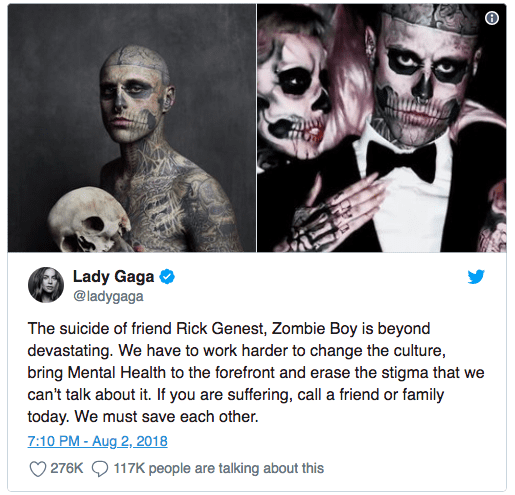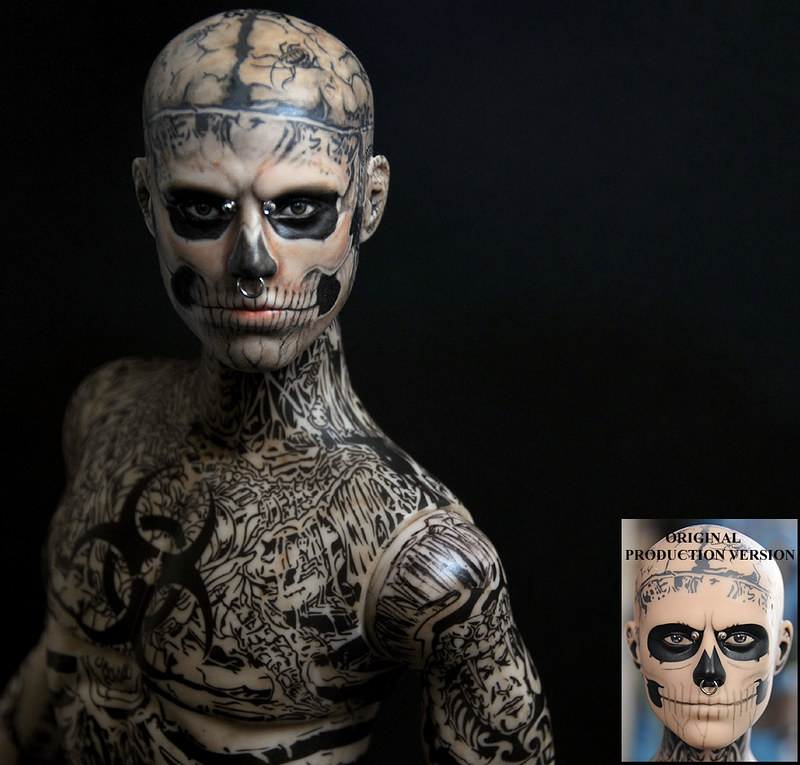
“His is an unusual story about a rebel who would embrace the mythos of death but defy death itself on its first try. It’s also an inspiring story about an unlikely model who redefined beauty with ink, but would ultimately succumb to the reaper on its second go at his young life.”
Art by David Castellanos
Tattoos are permanent.
That’s what everyone says. “Be careful what you get because you’ll have it forever!” They’ll tell you.
But when you think about it, the longevity of tattoos is actually entirely dependent upon the bodies that carry them to endure, however long that may be.
Ink relies on the body to withstand illness, bang-ups, and bruises. In turn, the body relies on the mind to endure things like struggle, misfortune, or alienation in society, for the sake of personal authenticity as expressed in the flesh, and to the benefit of posterity for the art.
So what endures forever? How can anyone justify the use of that word? How should we quantify it?
Because if we’re talking about something physically permanent (and we usually are,) tattoos aren’t really that. Tattoos are art pieces that can only exist for the length of the life of the skin they take residence on.
So what then, of Rick Genest?
He was a living mascot for the tattoo industry: a symbol of the role the tattoo performs to tell a person’s story. His tattoos were his identity and his career, but they also told the story of his life.
Rick Genest, “Rico the Zombie,” or “Zombie Boy,” began his tattoo journey at only five years old. He told The Mirror that he would save pennies for temporary tattoos from bubble gum machines and transfer them all over his tiny limbs.
At fifteen years old, Rick was diagnosed with a life-threatening brain tumor and was informed that the surgery to remove it was likely to kill him, or at best, disfigure him. Incredibly, he came out unscathed. He did not, however, come out unaffected.
Rick felt that the experience of trying to ready himself for death at an early age acted as a catalyst for his obsession with horror and all things macabre.
His is an unusual story about a rebel who would embrace the mythos of death but defy death itself on its first try. It’s also an inspiring story about an unlikely model who redefined beauty with ink but would ultimately succumb to the reaper on its second go at his young life.
He was a dead man walking. Like a zombie.
“My tattoos are about the human body as a decomposing corpse – the art of a rotting cadaver. It’s also a tribute to horror movies, which I love,”
-Rick Genest, Bizarre Magazine 2006.
At the age of sixteen, Rick Genest began to accumulate pieces of “his project” quickly but organically. His artist, Frank Lewis of Montreal, masterminded his full body skeletal tattoo, which according to his website, covered 90% of his body.
Rick would reflect back on his life-saving surgery frequently in interviews as having emboldened him to execute his “living skeleton” project. “Since then,” he explained, “I knew that life is too short to not fulfill my dreams of tattoos and body modifications.” (The Mirror)
Later, he spent time with freak shows and sideshows and developed stunts. He wasn’t merely resigned to “freakishness”; he was passionate about it.
Zombie Boy and his fellow performers put together their own show called “Lucifer’s Blasphemous Mad Macabre Torture Carnage Carnival,” and he spoke about it enthusiastically in promotional materials.
In the mainstream, Rick Genest saw success as a fashion model, eventually landing his career-defining role in Lady Gaga’s video for “Born this Way.”
Then, at the age of 32, Rick’s story abruptly ended.
It was Lady Gaga who would announce Rick Genest to the mainstream, and Lady Gaga who would announce via Twitter early this month that he had taken his own life..
..perhaps incorrectly.

The responding officers called it an apparent suicide before she did, but Gaga apologized after Rick’s family protested, explaining that there was insufficient evidence to assume his fall was intentional.
His manager really threw us through a loop by posting one of Rick’s poems to Zombie Boy’s Instagram. The poem, which seemed to be a commentary on death, posted the day after he died, leading everyone to believe he used some sort of delayed posting app to schedule a suicide note after the fact.
The mysterious nature of Rick’s passing was disconcerting to fans to say the least. In one narrative, Rick Genest was a silent sufferer of some unknown affliction. In another scenario, he was an unlucky smoker on a dangerous perch.
Choose your own adventure, I guess.
The irony is this: Rick was misunderstood in life, and misunderstood in death.
“I DIDN’T DO THIS BECAUSE
I WANTED TO BE DIFFERENT, I DID THIS
BECAUSE I WANTED TO BE MYSELF”-Zombie Boy, RickGenest.com
It’s not like you can ever really know what a person is struggling with, or whether they’ll win or lose. That said, I personally don’t believe he committed suicide. Maybe because I might mistakenly believe that when you put that much work into your body, you plan to keep it.
Because getting tattooed is an act of self-love.
Or maybe it’s because reviewing the videos that feature him exposes the viewer to Rick Genest’s goofy, childlike personality. He seemed to be an easy going person who was genuinely excited to be alive.

In his TedX Talk, he tells us many times, “I stand out.” He tells us this was true even before his ink.
Despite his feelings of isolation or his experiences with homelessness, Rico the Zombie told his story with humor and candor, punctuating his statements with childlike giggles.
Genest didn’t seem to reflect negatively on any of his experiences but instead saw them as formative. This is particularly true of his time on the street, where he was influenced irrevocably by the Punk culture he immersed himself in.
As for the life-threatening brain tumor he survived, it seemed to give him good reason to take death seriously, while at the same time remembering not to take life too seriously.
It’s an inspiring notion really.
The thing is, we don’t have to speculate about Rick Genest’s last moments. They probably aren’t the most important ones anyway, and they really aren’t any of our business.
Be them excruciatingly painful, or tragically clumsy, those moments are the part of his story he takes to the grave, maybe to hash out with God.. or whatever he believed in.
Fortunately, he’s left us enough to understand him with: his own recorded words together with Frank Lewis’s frequently photographed art.
Like most, I never knew the deceased, and yet somehow, being a part of the industry, this feels close to me.
I suppose that when you’re working as a tattoo artist, you’re carving a collaborative expression into the skin of your client.
Maybe it’s your friend, maybe it’s both.
You might expect to see them back in a few months or years and you hope that together you can seal the concept of permanence in pretty, shiny perfection with a touch-up.
You would expect that when this person leaves your studio, they will carry that art around, and you hope that it heals well. You hope they’ll care for it.
Furthermore, you hope that the expression will land with eloquence on the eyes and in the minds of all who view it, so long as it lives. Maybe it will attain a sort of immortality.
You don’t think about how unexpectedly short the life of a client or a friend might be, and by extension, your tattoo. You might think about the other invisible wounds that they have, as you bleed them out with your machine, in a kind of catharsis you are never able to bandage.
You might think about the hours of investment you’ve put into their work, but not about the hours you invest into their lives, until its all over and you wonder if it was enough.
When you have ink, you surrender yourself in some ways.
As the living canvas, your skin doesn’t belong to you the way it did. In a way, it sort of belongs to everyone; to view, to admire, to interpret. Anyone with a lot of ink knows a tattoo speaks.
Anyone with a lot of ink knows that we are patrons of art, as we host our pieces on our skin like dermal curators. The strength of our exhibition is in the strength of our work, and the strength of the gallery is in ourselves.
This leaves us then, with a simple truth:
When you take your life, you take a piece of art out of the world.
Maybe we should have always known this. Whether we’re talking about a friend, client, or stranger, with or without tattoos; whether it’s suicide or accidental death, this is true for everyone. It’s just so damn literal when Rick Genest does it, that this last bit of unsaid wisdom seems so apparent.
Life is by nature impermanent, and we should take in the stories of others and the art on their skin, as well as in their hearts, as long as we can.
So we grieve for Rick Genest, the person, and Zombie Boy, the enigmatic figure, and all at once the human piece of art. Luckily for us, your story can, in fact, attain immortality, because like one fan reminds us, “Zombies don’t die.”
Thank you to Rico the Zombie for the courage you had to be yourself. Thank you for sharing “your project” with us, and in doing so, teaching us that we can be anything, and that we should create ourselves.. right now.
Because life really is too short not to.
P.S. Here’s a little more of what’s left behind for us:
Tonner Doll made a Zombie Boy doll for $159 that sold out:

And then Noel Cruz repainted it and sold it on Ebay for $538.88
And Marc Quinn created a true to life sculpture for London’s Science Museum:

What’s your project?

